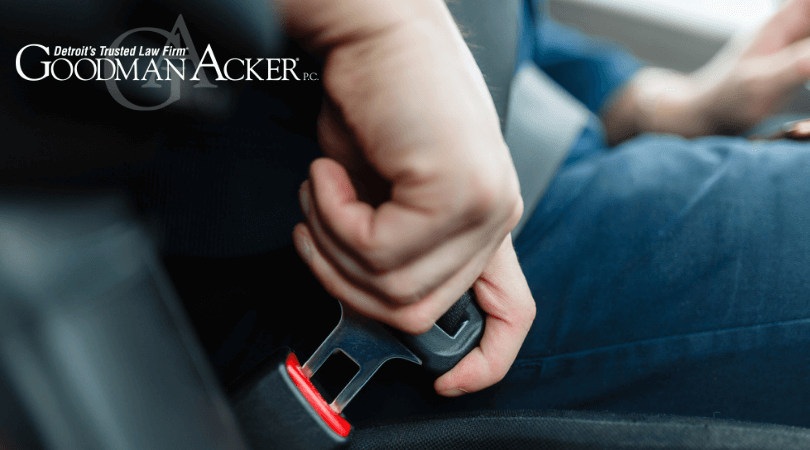- October 29, 2020
 Seatbelts are a lifesaver, so it’s a no-brainer that you should wear them when in a vehicle. This is the law in all U.S. states. However, sometimes you might drive or be a passenger in a car without wearing a seatbelt, leading to penalties like a ticket.
Seatbelts are a lifesaver, so it’s a no-brainer that you should wear them when in a vehicle. This is the law in all U.S. states. However, sometimes you might drive or be a passenger in a car without wearing a seatbelt, leading to penalties like a ticket.This blog looks at the seatbelt law in Michigan and whether you can get a ticket for not wearing a seatbelt in Michigan. Also, not wearing a seatbelt might affect your claims if you get into an accident. Our car accident lawyers at Goodman Acker P.C. can explain the consequences of not wearing a seatbelt and represent you in a compensation claim.
Contact us at 248-286-8100 for more information.
Why Should You Contact Goodman Acker P.C.?
At Goodman Acker P.C., we understand the Michigan legal system and the applicable laws that impact car accident claims, whether with your no-fault insurance policy or a negligent at-fault party. Therefore, we will provide sound legal advice after examining the facts of your case and help you commence the claims process where legal action is needed.
Let us help you fight for your rights and mitigate the impact of not wearing a seatbelt if you have a claim. Call us at 248-286-8100 for a free consultation.
Will I Get a Ticket for Not Wearing a Seatbelt in Michigan?
Yes. You can get a ticket for not wearing a seatbelt in Michigan. You can even get ticketed if your passenger is not wearing a seatbelt. Under Michigan’s seatbelt law, all passengers ages 8 to 15 must buckle up when seated in a motor vehicle, along with all drivers and front seat passengers.
Children younger than three must ride in a car seat in the vehicle's rear (with certain exceptions). Also, all children must ride in a car seat or booster seat until they are 8 years old or are 4 feet-9 inches tall.
In 2018, Michigan joined the nationwide “Click It or Ticket” campaign and issued $65 tickets for unbuckled drivers and front-seat passengers. In 2021, 254 people who failed to wear seatbelts died in traffic crashes, an 11.4% increase from the 228 fatalities in 2020. Each year, the Michigan Office of Highway Safety Planning (OHSP) hosts a period of extended enforcement for seatbelt-related infractions, but the time frame is not fixed.
In 2020, the Click It or Ticket campaign ran from October 17 through 31; in 2023, it ran from May 15 to June 4. You should always check for notices to know when the campaign will run to avoid getting caught and paying the $65 ticket. Even outside the campaign period, though, you should always wear your seatbelt.
Why Wear a Seatbelt?
In addition to helping you avoid a $65 fine, wearing a seatbelt could save your life. According to the Michigan State Police, seatbelt use reduces the risk of fatal injury to front-seat passenger car occupants by 45%. Data from the National Highway Traffic Administration (NHTSA) shows seatbelts have saved 344,448 lives since 1975.
In 2017 alone, seatbelts saved nearly 15,000 lives. NHTSA statistics place the rate of seatbelt use at above 91% in 2022. However, in 2021 50% of the 26,325 people killed in car accidents could have been saved if they had worn a seatbelt. Ultimately, seatbelts keep you from being ejected from your vehicle and enhance the efficiency of other safety features, like airbags, but only if you use them correctly.
How to Wear a Seatbelt Properly
Wearing your seatbelt correctly is the most effective way to protect yourself in a crash and defend yourself from impaired, aggressive, and distracted drivers. Here’s how to wear a seatbelt correctly:
- Secure your lap belt across your pelvis and your shoulder belt across the rib cage. These are some of the strongest parts of your body, and they can better withstand a crash.
- Your shoulder belt should fall across the middle of your chest and away from your neck, and your lap belt should fit across your hips – not your stomach.
- If your seatbelt isn’t comfortable, consider using seatbelt adjusters. Seatbelt extenders can also give you more room.
- NEVER put the shoulder belt behind your back or under your arm.
For added safety, consider retrofitting older cars with lap/shoulder belts instead of relying on lap belts only. If you’re buying a new car, check to see that the seatbelt fits you.
The NHTSA has an entire manual on proper seat belt use and advice for buckling up if you are pregnant. Wear your seatbelt every time you get in a car – and adjust it to serve you best.
Can You Get a Ticket for Not Wearing a Seatbelt in Michigan FAQs
There are several questions on the effect of not wearing a seatbelt and the impact on receiving compensation after an accident. Below are some of the common questions.
What Happens When I Don’t Wear a Seatbelt?
You risk getting ejected in a high-impact collision if you don't wear a seatbelt. Also, your airbag will not deploy properly, increasing the risk of head injury.
Can I File a Compensation Claim Even If I Did Not Wear a Seatbelt?
Yes. If another driver’s negligence caused the accident and you suffered debilitating injuries, you can file a compensation claim or lawsuit.
Will Getting a Ticket for Not Wearing a Seatbelt Affect My Settlement in a Car Accident Case?
Yes. If the defendant party can prove that your injuries were aggravated because you did not wear a seatbelt, it will affect your settlement. This is because Michigan’s modified comparative negligence law will come into play.
What Should I Do If My Insurance Company Denies My Claim Because I Did Not Wear a Seatbelt?
Contact our car accident lawyers at Goodman Acker P.C. immediately. We will review your case and advise you on how to proceed.
Were You Injured in an Accident Without a Seatbelt? Our Car Accident Lawyers Can Help
At Goodman Acker P.C., we recommend you wear a seatbelt 100% of the time. That being said, we also understand that you are human and sometimes you forget. You may face an insurance headache if you are injured in an accident without your seatbelt.
Insurance companies often claim that your injuries would not have happened if you had worn a seatbelt. But they only use this tactic when the accident would not have happened if the drivers they insured drove carefully. When another’s negligence harms you, your seatbelt use (or lack thereof) should not jeopardize your access to justice and compensation.
Therefore, even if you were not wearing a seatbelt, you are still entitled to some compensation, and our attorneys will ensure your rights are protected and work to get you a favorable outcome. Contact us at 248-286-8100 immediately after the accident.

